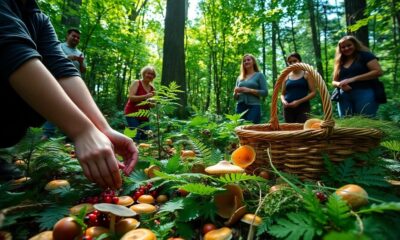Uncategorized
When Did Foraging Begin? The Ancient Secret Hidden in Prehistoric Times!
Discover the intriguing origins of foraging and how ancient practices shaped our survival; the secrets of prehistoric times await your exploration!

Foraging began about 200,000 years ago when early humans relied on wild plants and animals for survival. During this time, you'd gather around 500 types of food each year, mostly from plants. This practice remained essential even after agriculture started around 12,000 years ago. As climate changed, so did your foraging techniques, enhancing your chances of survival. The use of tools improved your gathering efficiency, while social structures supported community bonds. If you're curious about how these ancient practices shaped modern nourishment and culture, there's even more fascinating history waiting for you to uncover!
Key Takeaways
- Foraging practices began approximately 200,000 years ago with the emergence of Homo sapiens.
- Early humans gathered around 500 food varieties annually, primarily plant-based.
- Foraging remained essential even after the advent of agriculture around 12,000 years ago.
- Specialized tools developed about 80,000 to 70,000 years ago enhanced foraging efficiency.
- Climate change continuously influenced foraging techniques and food availability throughout prehistoric times.
Origins of Foraging Practices
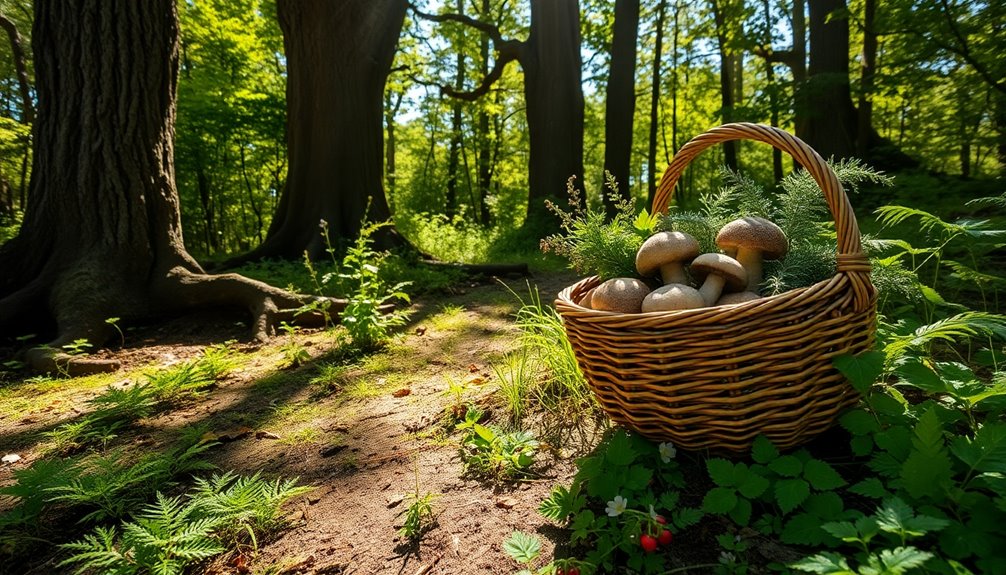
Foraging practices have roots that trace back about 200,000 years to the emergence of Homo sapiens, making it the primary way early humans sustained themselves. These practices weren't just a means of survival; they reflected a deep connection with the environment.
You'd find that early humans relied heavily on their extensive knowledge of local flora and fauna, gathering around 500 varieties of food annually. Archaeological evidence shows that their diets consisted of 60-80% plant foods, highlighting the importance of foraging in their nutrition.
Even with the shift to agriculture around 12,000 years ago, foraging remained a vital aspect of their diets. This adaptability is key to understanding how early humans thrived in diverse environments.
The endurance running hypothesis suggests that persistence hunting, a specific foraging strategy, played a significant role in human evolution. By honing these foraging practices, early humans developed skills that allowed them to exploit various resources effectively.
In essence, foraging practices weren't merely survival tactics; they were foundational elements that shaped the way early humans interacted with their world and adapted over millennia.
The Role of Hunter-Gatherers

When Did Foraging Begin? The Ancient Secret Hidden in Prehistoric Times!
The Role of Hunter-Gatherers
Living as hunter-gatherers, early humans developed a lifestyle that deeply intertwined them with their environment. For roughly 200,000 years, these communities thrived by foraging for wild edible plants, insects, fungi, and game, making up 60-80% of their caloric intake. Unlike agricultural societies, hunter-gatherers typically engaged in subsistence work only 2-3 days a week, enjoying significant leisure time.
| Aspect | Details | Impact |
|---|---|---|
| Diet | Wild plants, insects, and game | Nutritionally diverse |
| Work Schedule | 2-3 days per week | More leisure time |
| Social Structure | Egalitarian, kinship-based | Strong community bonds |
| Gender Roles | Women hunt in 79% of societies | Challenged traditional views |
| Duration of Lifestyle | Approximately 200,000 years ago | Foundation of human existence |
Hunter-gatherer communities relied on resource sharing and close social ties, which fostered cooperation and resilience. Understanding their role in human history not only highlights their adaptability but also offers insights into the origins of social structures that continue to influence us today. Moreover, their lifestyle may have parallels with the concept of social bonds that are crucial for emotional well-being, similar to the benefits seen in pet therapy for dementia and Parkinson's patients.
Evolution of Food Sources
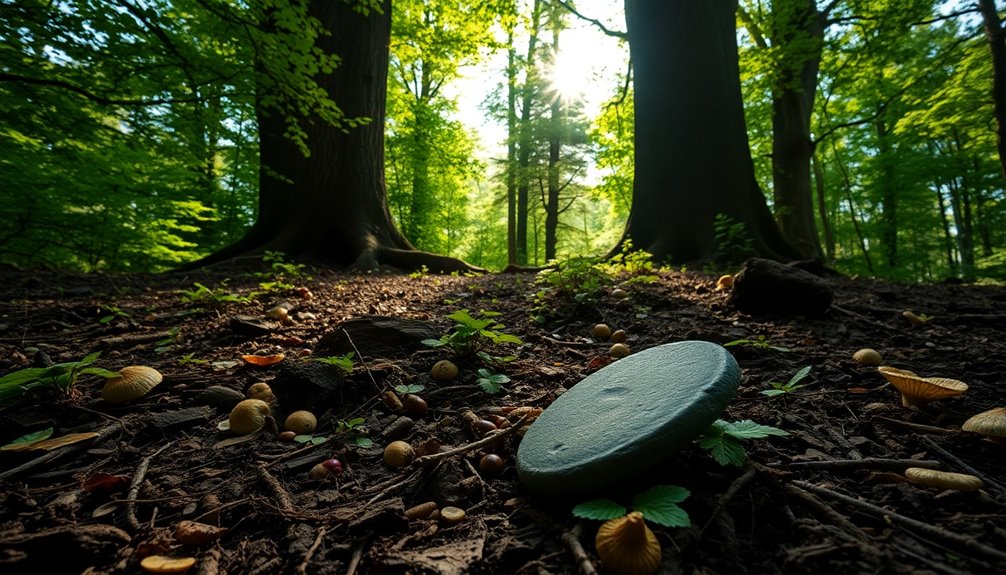
As you explore the evolution of food sources, consider how early foraging techniques shaped human diets and survival strategies.
Climate change played a vital role in influencing the availability of food, pushing hunter-gatherers to adapt their methods.
You'll see how these factors laid the groundwork for the eventual shift to agriculture.
Early Foraging Techniques
Throughout the early days of human existence, hunter-gatherers relied heavily on their surroundings to meet dietary needs. For about 200,000 years, they practiced hunting and gathering, harvesting wild edible plants, insects, and game. Evidence shows that plants made up 60-80% of their annual diet by weight, highlighting the critical role these foraged food sources played in their nutrition.
You'd be amazed at the extensive knowledge these early humans developed regarding local flora and fauna. They identified over 500 varieties of food annually and used seasonal calendars to track plant growth and animal breeding cycles, guaranteeing they knew when to forage or hunt.
Around 80,000 to 70,000 years ago, the emergence of specialized tools, such as fishing nets and harpoons, marked a leap in foraging efficiency.
Sustainable resource management was also key; these foragers minimized waste and guaranteed food sources remained available for future generations. By adapting to their environment and honing their skills, they laid the groundwork for the eventual shift to agriculture, but their early foraging techniques remain a tribute to human ingenuity and resilience.
Impact of Climate Change
The early foraging techniques developed by hunter-gatherers were continuously shaped by the changing climate. As the last Ice Age ended, you'd notice how climate change influenced food availability, prompting adaptations in foraging strategies.
With rising temperatures and retreating ice, diverse ecosystems emerged, allowing early humans to explore a variety of plant foods and animals. The shift from glacial to interglacial periods forced you to adjust your hunting techniques, focusing more on smaller game and seasonal foraging.
Key impacts of climate change on foraging included:
- Resource Availability: Increased temperatures led to a wider range of food sources.
- Diet Diversification: You began to exploit more plant foods, enhancing nutritional options.
- Seasonal Patterns: Foraging aligned with cycles of resource availability, adapting to changing conditions.
- Domestication: Gradual warming facilitated the domestication of plants and animals, setting the stage for agriculture.
These changes profoundly influenced your ancestors' diets, pushing them toward more sustainable practices that would eventually lead to agricultural development.
The legacy of climate change in shaping food sources continues to echo in our modern diets.
Social Structures in Foraging Societies

In foraging societies, you'll notice a strong emphasis on egalitarian social dynamics, where leadership shifts based on situational needs rather than permanent roles.
Kinship ties and band memberships create essential support networks, shaping how communities function.
Notably, gender roles blur as women often take on significant hunting responsibilities, highlighting their active contributions to the group's survival.
Egalitarian Social Dynamics
Amid the diverse landscapes of prehistoric times, egalitarian social dynamics defined hunter-gatherer societies. These groups operated under an egalitarian ethos, emphasizing equality among members. Leadership was situational and temporary, fostering a sense of shared responsibility and minimizing hierarchical structures.
You can see this in several ways:
- Kinship and Band Membership: Social ties were primarily based on family connections rather than rigid class systems.
- Temporary Leadership: Leaders emerged during specific tasks or challenges, ensuring that power wasn't concentrated in a single individual.
- Low Inequality: The average Gini coefficient of 0.25 among hunter-gatherers indicates some level of inequality but remains considerably lower than in agricultural or industrial societies.
- Specialized Roles: Evidence suggests the emergence of specialized roles in hunting and gathering activities about 80,000 to 70,000 years ago, highlighting the complexity within these egalitarian structures.
Gender Roles and Contributions
Egalitarian social dynamics in hunter-gatherer societies naturally influenced gender roles and contributions. Historically, both men and women played crucial roles in food acquisition, challenging traditional views that often depicted men solely as hunters and women as gatherers. In fact, studies reveal that women participated in hunting in 79% of modern foraging societies, demonstrating their significant contributions.
The table below summarizes the various contributions of gender roles in these societies:
| Gender Role | Contributions |
|---|---|
| Men | Primary hunters, larger game tracking |
| Women | Hunting small game, gathering, tracking |
| Both | Collective decision-making, resource sharing |
| Leaders | Situational leadership based on needs |
| All Members | Cooperation and adaptability |
In these social structures, leadership wasn't permanent and was based on immediate needs. This situational approach allowed for greater resilience and adaptability in response to environmental changes. By understanding gender roles in human history, you can appreciate how these diverse contributions shaped the survival strategies of our ancestors, fostering cooperation and resource sharing essential for thriving in challenging environments.
Kinship and Band Structure
Kinship and band structure form the backbone of social organization in foraging societies, fostering cooperation and resource sharing among members. In hunter-gatherer communities, these ties are crucial for survival and social cohesion.
You'll notice several key features in these structures:
- Egalitarian Ethos: Everyone has a role, and decisions often reflect the group's collective needs rather than a single leader's agenda.
- Situational Leadership: Leadership is flexible, emerging based on the specific context and expertise required, which allows for adaptive responses to challenges.
- Matrilocal Residence: Many societies practice matrilocal postmarital residence, ensuring that young mothers benefit from family support and communal resources.
- Gender Roles: Contrary to traditional views, modern studies show that women participate in hunting activities in 79% of contemporary hunter-gatherer societies, promoting a more fluid understanding of gender roles.
These kinship structures create a complex web of interpersonal relationships, ensuring mutual aid and resource allocation.
Through these connections, hunters and gatherers thrive, maintaining social bonds that are essential for their way of life. Additionally, the importance of community building in these societies highlights their resilience and adaptability in facing environmental challenges.
Tools and Techniques for Foraging
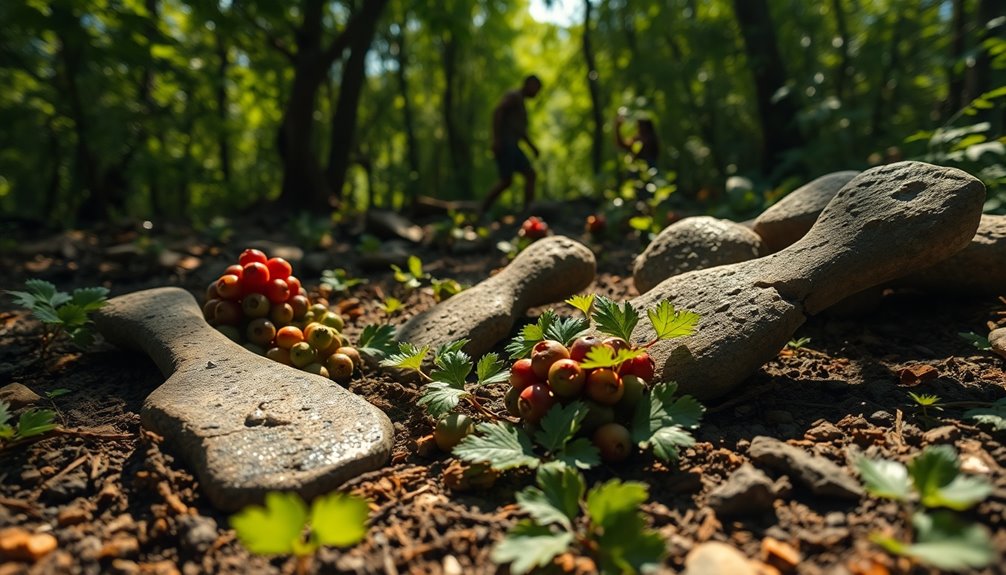
As foragers developed their skills, they also created specialized tools that greatly improved their ability to gather food. Archaeological excavations reveal evidence of fishing nets and harpoons, which enhanced efficiency in resource gathering.
You'd be surprised to learn that hunter-gatherers utilized over 500 varieties of food annually, showcasing their extensive knowledge of local flora and fauna for foraging.
To optimize their foraging techniques, prehistoric foragers employed seasonal calendars to track the growth cycles of plants and the breeding patterns of animals. By understanding these patterns, they could time their foraging activities more effectively.
Additionally, the controlled use of fire played a crucial role in their strategies, promoting seed germination and improving access to edible plants.
The endurance running hypothesis also highlights an innovative foraging strategy known as persistence hunting. This method required adaptability, allowing early human foragers to thrive in diverse ecological conditions.
Dietary Diversity in Prehistoric Times
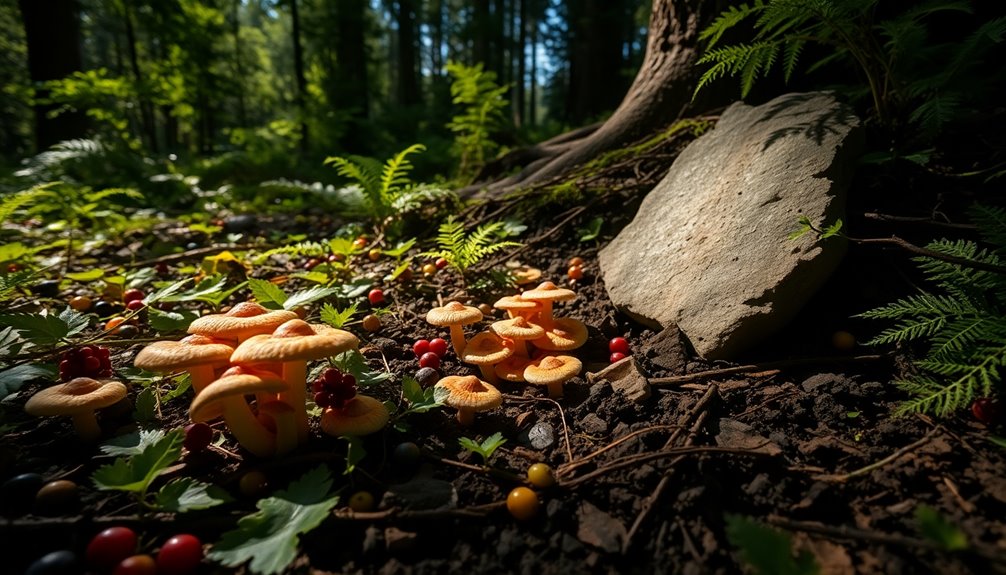
Prehistoric diets were anything but monotonous; they thrived on a rich tapestry of flavors and nutrients. The dietary diversity of hunter-gatherers during the Stone Age was impressive, with plant foods accounting for 60-80% of their annual caloric intake. They utilized over 500 varieties of food each year, showcasing their extensive knowledge of local flora and fauna.
To maintain this variety, prehistoric groups employed seasonal calendars to track key cycles, ensuring a sustainable diet throughout the year. Their approach to foraging included:
- Utilizing diverse plant species: They gathered fruits, nuts, seeds, and tubers, capitalizing on the seasonal availability.
- Hunting various animals: This included small game, fish, and larger mammals, depending on the region.
- Incorporating spices: Archaeological findings, such as garlic mustard seeds in pottery, indicate that they engaged in sophisticated culinary practices.
- Leisure time for exploration: With only 2-3 days of work each week to procure food, they'd ample time to explore new dietary options.
This rich dietary diversity not only met their nutritional needs but also contributed to a vibrant culture and lifestyle. Additionally, their diet likely included high omega-3 content from various seeds, which were essential for maintaining overall health and cognitive function.
Impact of Climate on Foraging

Climate played an essential role in shaping foraging practices among ancient human populations. During the Pleistocene epoch, fluctuations between glacial and interglacial periods affected the abundance of wild food resources. As the last Ice Age ended around 11,700 years ago, the world warmed, creating wetter conditions that expanded diverse flora and fauna. This shift allowed hunter-gatherers to enhance their foraging opportunities considerably.
With regional climates varying, foraging techniques adapted locally. You'd notice groups migrating seasonally to exploit different food sources, ensuring they always had something to eat. The evidence of plant and animal remains found at archaeological sites shows how these ancient people adjusted their strategies in response to climate changes, maintaining food security amidst environmental challenges.
In the Neolithic period, as climate continued to evolve, fewer hours were spent searching for food, thanks to more abundant and reliable sources. This adaptation was vital for survival, as it directly impacted the availability and distribution of edible plants and game.
Ultimately, understanding these climatic influences reveals how prehistoric societies thrived, showcasing their resilience in a changing world.
Transition to Agriculture
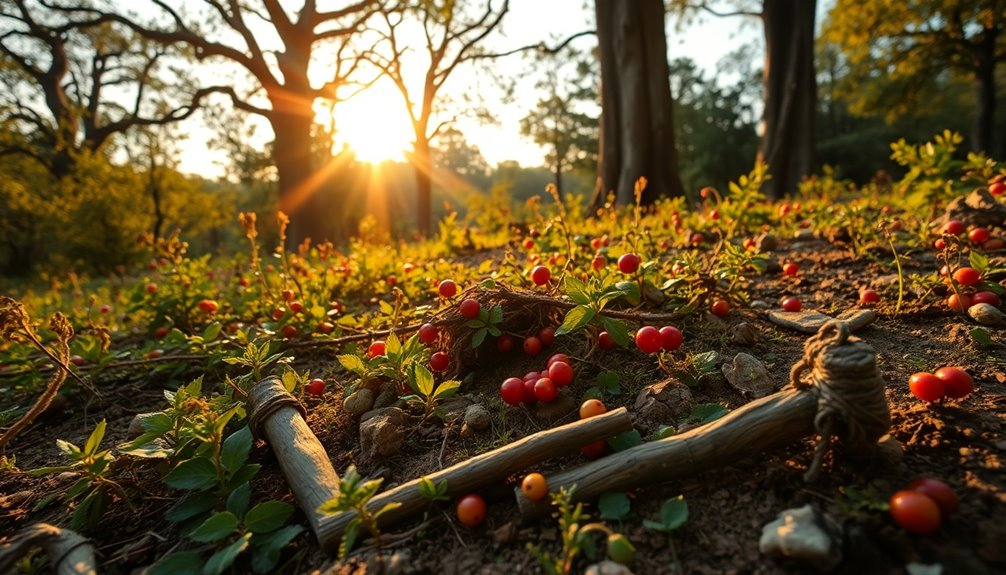
The shift from foraging to agriculture, often referred to as the Neolithic Revolution, marked a pivotal moment in human history. This change to agriculture began around 11,000 years ago, but evidence suggests that early agricultural practices may date back even earlier, with signs of wild grain exploitation identified as far back as 14,500 years ago.
Rather than being a sudden invention, the move toward farming was a gradual process influenced by various factors.
Here are four key aspects of this change:
- Environmental Changes: Shifts in climate and landscape created new opportunities for farming.
- Resource Availability: Increased access to wild grains and domesticable plants encouraged agricultural practices.
- Mixed Strategies: Early humans combined hunting, fishing, and foraging with nascent farming techniques for thousands of years.
- Crop Failures: Challenges and uncertainties in farming reinforced the importance of traditional foraging methods, delaying a complete reliance on agriculture.
In this complex evolution, the Neolithic Revolution laid the foundation for the societies and civilizations that would follow, fundamentally altering the human experience.
Archaeological Discoveries and Insights

Archaeological discoveries have shed light on the culinary practices of prehistoric hunter-gatherers, revealing that their diets were more sophisticated than previously thought. For instance, remnants of garlic mustard seeds found in a pottery fragment from Neustadt, Germany, date back at least 5,900 years. This shows that these communities used native spices long before agriculture became mainstream.
| Archaeological Site | Findings | Age (Years) |
|---|---|---|
| Neustadt, Germany | Garlic mustard seeds | 5,900 |
| Denmark | Crushed mustard seeds | 4,000 – 5,000 |
| Various Sites | Phytoliths (plant microfossils) | Thousands of years |
The microscopic analysis of food residues in Denmark and Germany also indicates that Stone Age societies were both complex and creative in their culinary practices. The identification of phytoliths serves as a "fingerprint," confirming the use of spices. These findings challenge earlier beliefs that prehistoric diets were solely focused on caloric intake, emphasizing the social dynamics and prestige associated with cooking in hunter-gatherer societies.
Modern Foraging Movements

In recent years, a growing interest in foraging has sparked a movement that encourages people to seek out sustainable food sources and reconnect with nature. This shift isn't just a trend; it's a response to the drawbacks of industrial society and a quest for food sovereignty.
Here's how modern foraging movements are thriving:
- Workshops and Guided Trips: Organizations offer hands-on learning experiences, teaching you to identify edible plants and fungi safely. Additionally, understanding aromatherapy techniques can enhance your overall experience in nature by promoting relaxation and mindfulness.
- Urban Foraging: Many discover that city parks and gardens are teeming with edible plants, promoting biodiversity in urban environments.
- Community Engagement: Foraging groups create supportive networks, where you can share experiences and knowledge, enhancing your skills.
- Social Media Influence: Platforms like Instagram and Facebook allow enthusiasts to connect, share recipes, and document their foraging adventures, fostering a vibrant community. Additionally, understanding sustainable harvesting practices is essential to ensure that foraging activities do not harm local ecosystems.
Frequently Asked Questions
When Did Foraging Begin?
Foraging began around 200,000 years ago when early humans relied on wild edible plants for survival.
You'd gather diverse foods, with plants making up a significant portion of your diet. This practice shaped how communities interacted with their environment, using over 500 food varieties annually.
As agriculture emerged about 10,000 to 12,000 years ago, foraging slowly shifted to farming, but the skills and knowledge you gained remained essential for sustaining life.
When Did Humans Stop Being Foragers?
When it comes to evolving from foraging, you're looking at a significant turning point around 10,000 to 12,000 years ago.
People started trading their hunting-gathering lifestyle for agriculture during the Neolithic Revolution. This shift didn't happen overnight; it took time to blend farming with traditional practices.
Eventually, as societies grew, folks relied more on farming, putting aside foraging as their primary source of sustenance.
It's a classic case of adapting to survive!
Is Foraging Paleolithic or Neolithic?
Foraging primarily belongs to the Paleolithic era, when early humans relied on wild plants, animals, and fish for sustenance.
However, it didn't disappear with the rise of agriculture in the Neolithic period; instead, it coexisted with farming practices for thousands of years.
When Did the Hunter-Gatherer Era Start?
The hunter-gatherer era started around 2.5 million years ago, when early hominins began relying on foraging and hunting for survival.
You'd find these groups living in small, mobile units, constantly adapting to their environments. They exploited diverse ecosystems, gathering wild plants and hunting animals.
This lifestyle dominated human existence for about 95% of our history, shaping social structures and knowledge about local flora and fauna long before agriculture emerged about 10,000 to 12,000 years ago.
Conclusion
In the grand tapestry of human history, foraging weaves a rich thread that connects us to our ancient ancestors. Understanding its origins and evolution reveals not just how we survived, but how we thrived. As you explore the world of foraging today, remember it's more than just gathering food—it's a dance with nature, a celebration of our shared past. So, step into the wild, and embrace the secrets the earth has to offer. Your journey awaits!
Uncategorized
How Much Forage Does a Cow Eat? The Number That’ll Blow Your Mind!
Surprising facts about cow forage intake will leave you amazed—discover the numbers that can transform your herd’s health and productivity!
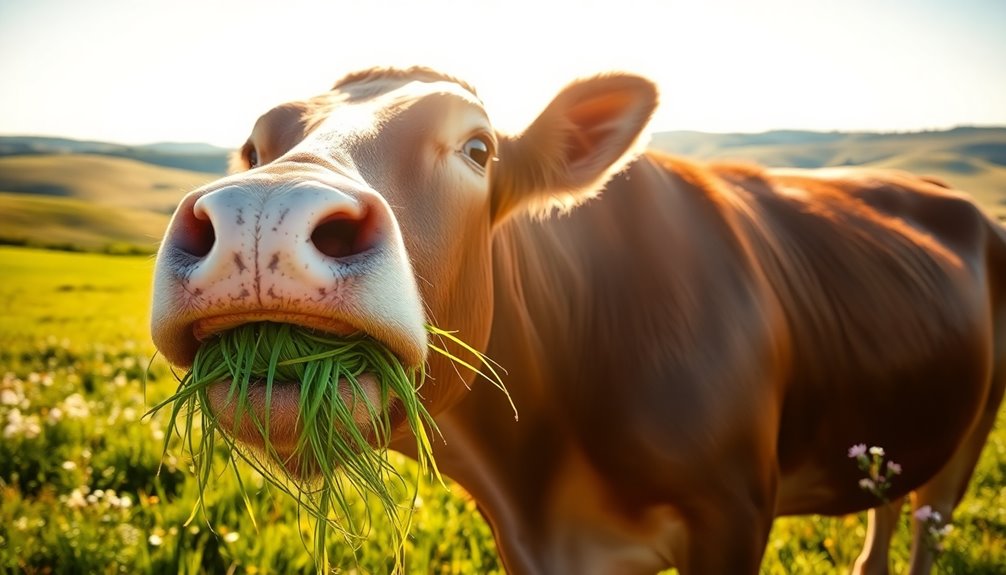
Cows can eat an eye-popping 2.5% to 2.7% of their body weight in forage daily, especially if they're lactating and on high-quality pastures. For a 1,200-pound cow, that means consuming around 30 pounds or more of forage each day! Factors like the cow's size, the forage quality, and whether they're pregnant or lactating all impact their intake. Higher-quality forage lets cows consume more, boosting their health and productivity. Want to uncover more fascinating facts about cow nutrition and feeding practices? There's plenty more to explore about how to optimize your herd's forage intake!
Key Takeaways
- A lactating cow weighing 1,200 lbs can consume up to 36 lbs of quality forage daily.
- Dry matter intake (DMI) typically ranges from 1.8% to 2.7% of a cow's body weight.
- High-quality forage (≥8% crude protein) allows for greater intake compared to low-quality forage (<6% crude protein).
- Seasonal changes can significantly impact daily forage consumption and availability.
- Larger cows require more forage, directly correlating their size with consumption levels.
Understanding Dry Matter Intake
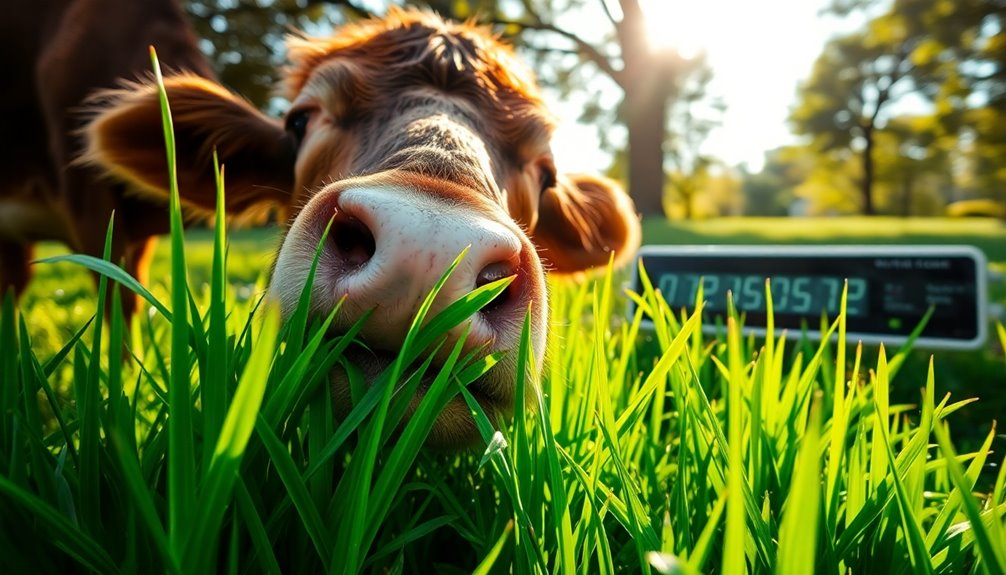
When it comes to managing your cattle's nutrition, understanding dry matter intake (DMI) is key. DMI refers to the amount of feed consumed after excluding moisture content, which is essential for accurate nutritional assessments.
For instance, a 1,200 lb cow that eats 24 lb of hay at 88% dry matter actually consumes about 27 lb on an as-fed basis due to moisture.
Factors like forage quality, cow weight, and lactation status greatly impact daily DMI. Lactating cows generally consume more than non-lactating cows to meet their nutrient needs, often reaching 2.5%-2.7% of their body weight when eating high-quality forages like corn silage.
Monitoring DMI helps you manage forage inventory effectively, particularly during periods of scarcity like calving, ensuring you minimize hay wastage and optimize feeding strategies.
Factors Influencing Forage Consumption
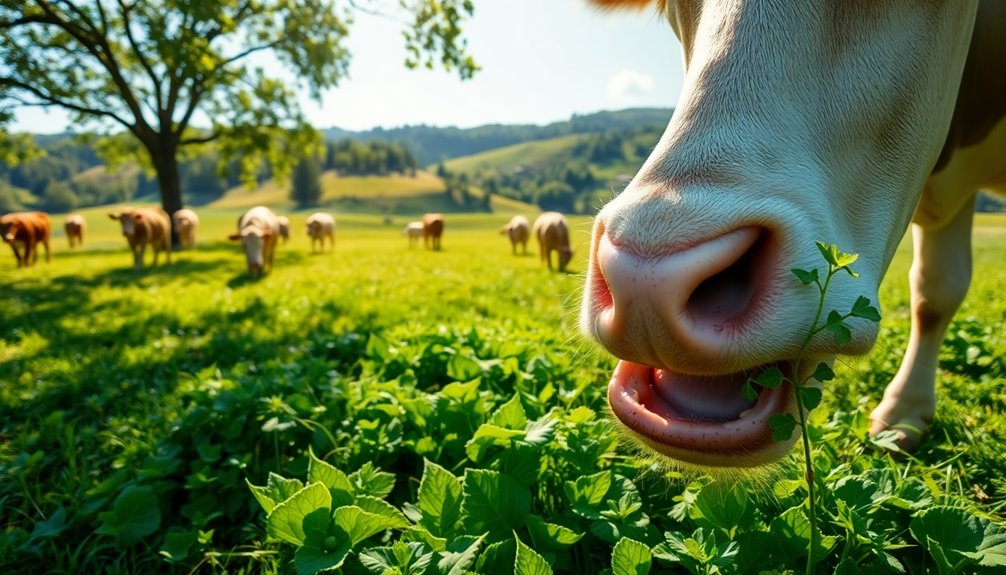
Forage consumption in cows is influenced by several critical factors, including forage quality, cow condition, and environmental conditions. Understanding these influences can help you enhance your cows' forage intake and overall health.
- Forage Quality: High-quality forage can increase daily intake considerably.
- Body Weight: A cow's size impacts its overall consumption; larger cows eat more.
- Nutrient Content: The Total Digestible Nutrients (TDN) in forage determines how much energy and nutrients a cow receives.
- Seasonal Variations: Changes in pasture availability can affect feeding needs.
For instance, a 1,200 lb lactating cow can consume about 28 lb of high-quality forage daily, especially when it contains around 55% TDN. In contrast, if you're feeding low-quality forages (≤52% TDN), expect a consumption rate of about 1.8% of body weight for non-lactating cows.
Additionally, lactating cows require about 50% more TDN than dry cows, demanding increased forage intake during their lactation period. By factoring in these elements, you can guarantee your cows receive ideal nutrition to maximize their productivity and health.
Quality of Forage Matters
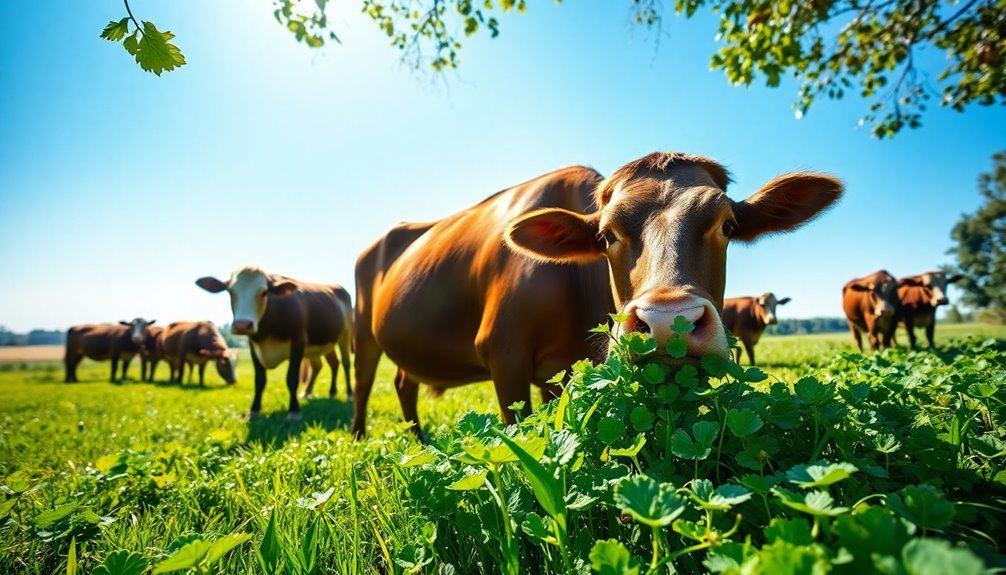
Quality of forage plays an essential role in determining how much cattle consume and their overall health. It's fascinating how the nutrient content can impact a cow's intake. For instance, when you provide low-quality forage with less than 6% crude protein, your cow may only consume around 1.5% of its body weight daily. In contrast, higher-quality forage containing at least 8% crude protein allows for approximately 2% body weight intake.
Here's a quick look at how different forage qualities can affect intake:
| Forage Quality | Crude Protein (%) | Daily Intake (Pounds) |
|---|---|---|
| Low Quality | < 6% | ~18 lbs (1.5% BW) |
| Good Quality | 8% | ~24 lbs (2% BW) |
| Excellent Quality | ≥ 8% | ~30 lbs (2.5% BW) |
| High Digestibility | 55% TDN | ~28 lbs (Lactating) |
| Mature Forage | Varies | Reduced Intake |
The digestibility of these forages is significant. Better digestibility means your cow can absorb more nutrients, leading to improved health and productivity. Prioritizing quality forage is essential for maximizing your cow's potential.
Estimating Daily Feed Requirements
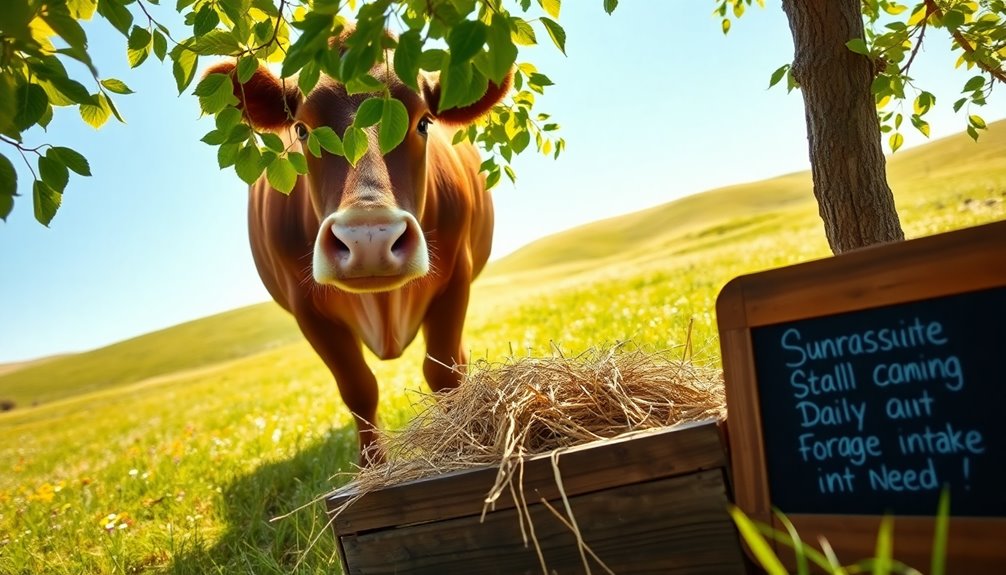
Understanding how much feed your cows need is essential for maintaining their health and productivity, especially after exploring how forage quality impacts their intake. When estimating daily feed requirements, you must consider factors like body weight, moisture content, and nutrient needs.
- A 1,200 lb pregnant cow typically consumes about 24 lbs of good-quality grass hay daily, factoring in a 15% hay wastage rate, which brings it to around 30 lbs.
- Lactating cows need more, consuming up to 36 lbs of as-fed hay daily to meet their heightened energy and nutrient needs.
- Dry matter intake for non-lactating cows is about 1.8% to 2.1% of their body weight, while lactating cows can reach 2.5% to 2.7%.
- Accurate estimates of daily feed intake help manage your forage inventory, especially during scarce periods.
Seasonal Feeding Strategies
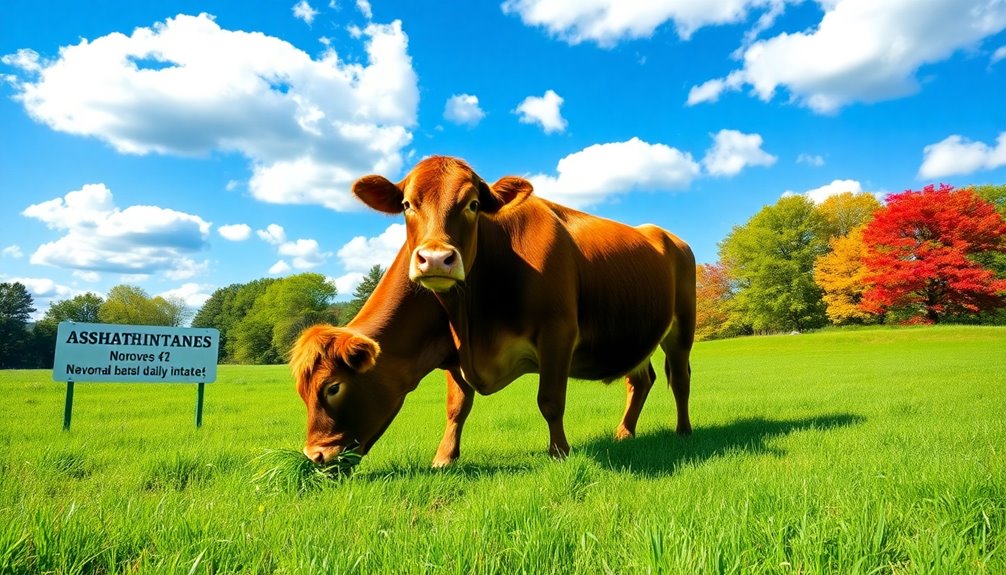
Adapting your feeding strategies throughout the seasons is vital for maintaining ideal cow health and productivity. Seasonal variations in forage availability can drastically affect your hay feeding needs, especially during fall and winter months when standing forage may be limited.
In the fall, utilizing native and Bermudagrass pastures can help reduce reliance on hay, allowing you to make the most of your available forage resources.
As winter sets in, you'll likely find pastures covered in snow or ice, making hay feeding more necessary. This is when it's important to accurately estimate your cows' daily intake needs to guarantee they receive the nutrition they require.
Keeping historical records of forage availability can assist you in predicting how long you'll need to feed hay and plan for any potential shortages.
Moreover, implementing supplementation programs during times of lower-quality forage can greatly enhance digestion and nutrient absorption, further supporting cow health and productivity.
Frequently Asked Questions
How Much Forage Does a Cow Eat per Day?
When you consider how much forage a cow eats daily, it really varies based on several factors.
A typical 1,200 lb pregnant cow usually consumes around 24 lbs of good-quality hay, but that can increase if the cow is lactating or if the forage quality is exceptional.
Generally, you can expect a non-lactating cow to eat about 2.0% of its body weight in good-quality forage, adjusting for moisture and wastage.
What Is the Mental Capacity of a Cow?
Cows have a remarkable mental capacity, comparable to that of a human toddler.
You'll find that they can solve problems and remember experiences for years. They recognize faces, both of other cows and humans, showcasing their strong memory.
Plus, they can learn by observing others, which helps them adapt.
Cows also experience emotions like joy and stress, affecting their well-being, and they communicate through vocalizations and body language to convey their feelings.
How Much Hay Will a 1200 Pound Cow Eat?
Imagine your 1,200-pound cow as a voracious bookworm, devouring pages of hay daily.
She'll munch through about 24 pounds of good-quality hay, about 2% of her body weight.
But wait! If the hay's moisture content is considered, that number jumps to around 26 pounds.
Factor in some wastage, and you'll need to provide about 30 pounds daily to keep her satisfied and healthy.
Adjust her intake as her needs change, especially after calving!
How Much Does a 1000 Lb Cow Eat a Day?
A 1,000 lb cow typically eats about 20 to 24 lbs of dry matter each day, which is roughly 2.0% to 2.4% of its body weight.
If you're feeding hay, that translates to around 25 to 28 lbs on an as-fed basis, depending on moisture content.
Keep in mind that quality matters; high-quality forages can increase intake to about 25 lbs or more.
Be sure to account for hay wastage, too!
Conclusion
To sum up, understanding how much forage a cow eats can really change your perspective on cattle management. Did you know that a single cow can consume up to 2.5% of its body weight in dry matter daily? That's around 30-40 pounds for an average cow! By considering factors like forage quality and seasonal variations, you can optimize your feeding strategies. Keeping these insights in mind can lead to healthier cattle and better yields for your farm.
Uncategorized
Is Forage Good for Internship? The Shocking Truth About This Opportunity!
Get ready to discover whether Forage can truly transform your internship experience in ways you never expected! What secrets lie ahead?

Forage is a fantastic opportunity for internships, especially if you're looking to build skills without the usual pressures. These virtual internships are structured by top companies and allow you to learn at your own pace. You won't face competitive applications, and they're free, making them accessible to everyone. You'll gain practical experience with tools and concepts relevant to your field. Plus, completing these programs gives you a recognized digital certificate to enhance your resume. If you're curious about how to make the most of this unique chance, you'll uncover essential tips just around the corner.
Key Takeaways
- Forage offers free virtual internships that enhance resumes with recognized digital certificates, making them a valuable addition for job applications.
- The self-paced format of Forage programs allows flexibility, enabling participants to learn without the pressure of strict schedules or assessments.
- Designed by leading companies, Forage internships build practical skills through real-world simulations, preparing participants for industry challenges.
- The programs are accessible to a diverse audience, including international students and those without prior work experience, promoting inclusivity in career exploration.
- Engaging in multiple Forage programs creates a well-rounded skill set, boosting confidence and employability for aspiring professionals.
Understanding Forage Programs

For those looking to gain real-world experience, Forage programs offer an excellent way to immerse yourself in virtual internships created by top companies in various fields. These programs span disciplines like marketing, engineering, banking, and law, providing you with valuable insights and skills directly relevant to your career aspirations.
Each Forage program typically takes about 4–5 hours to complete and includes self-paced modules filled with introductory videos, engaging assignments, and personalized feedback from industry professionals. This structure allows you to tackle real work scenarios, honing your practical skills while learning how to navigate tasks similar to those you'd encounter in a traditional internship.
When you finish a program, you receive a digital certificate that enhances your LinkedIn profile and resume, showcasing your practical experience to potential employers. This accessibility makes Forage an inclusive opportunity for everyone, including international students and those with no prior work experience.
Benefits of Virtual Internships

Virtual internships offer you the flexibility to learn on your own schedule, making them accessible no matter where you are.
You'll have the chance to develop valuable skills through real-world tasks, which prepares you for the job market. Additionally, hydration is crucial for maintaining optimal brain function during your learning process.
Plus, with no grades or assessments, you can focus on genuinely engaging with the content to enhance your personal growth. Additionally, they often encourage self-care practices that contribute to your overall well-being during the learning process.
Flexibility and Accessibility
While many internships come with rigid schedules and extensive application processes, the flexibility and accessibility of virtual internships, like those offered by Forage, make them an appealing option for students everywhere.
You can immerse yourself in these self-paced experiences without the hassle of applications or fees. This means you can explore your interests while managing your other commitments.
Here are three key benefits of virtual internships:
- Self-Paced Learning: Complete simulations in just 4–5 hours, allowing you to fit the work around your class schedule or job.
- Wide Range of Opportunities: Explore various career pathways, from marketing to engineering, giving you a taste of multiple fields before you commit.
- No Pressure: With no grading or assessments, you can focus on developing genuine skills instead of stressing over performance metrics.
These features not only offer you the flexibility to learn on your terms but also enhance your resume with valuable certificates, positioning you favorably for entry-level positions. Additionally, you can benefit from the optimal tanning frequency recommended in skin health guidelines to maintain your well-being while pursuing your internship.
Virtual work through Forage truly opens doors for every student, making internships more accessible than ever.
#
Skill Development Opportunities
Often, students discover that virtual internships offer invaluable skill development opportunities that prepare them for the workforce. Forage provides virtual Experience Programs that focus on building practical skills essential for entry-level positions, with programs designed by leading companies across various disciplines, including marketing and engineering. These programs not only enhance industry-specific skills but also promote teamwork skills crucial in collaborative work environments. Additionally, developing a strong brand identity through these experiences can significantly enhance your employability. Moreover, engaging in these simulations can also help you learn about the importance of risk management strategies in navigating professional challenges. The use of AI-powered technologies in these programs can also enhance the learning experience, making it more engaging and tailored to individual needs AI technologies.
You can complete self-paced simulations in about 4–5 hours, allowing you to efficiently develop skills without the pressure of grading or assessments. The platform emphasizes hands-on experience, enabling you to enhance your design, prototyping, and strategic thinking abilities through real-world tasks faced in the industry.
As you engage with Forage's simulations, you'll not only boost your confidence during job searches but also learn to manage feelings of rejection by recognizing the importance of practical experience in your career development. Additionally, immersing yourself in these simulations can help you understand the significance of collaboration across teams in achieving project success.
Plus, the certificates awarded upon completion of these simulations add significant value to your resume. They complement your online courses and certifications, making you a more appealing candidate to potential employers.
## Skill Development Opportunities

Skill development opportunities through Forage provide a unique way to enhance your resume while gaining practical experience.
As you engage with self-paced virtual internships, you'll find that these programs allow you to manage your time effectively while building essential skills.
I've gotten valuable insights from working with industry leaders like Accenture and Electronic Arts.
Here's what you can expect to develop:
- Competencies in Design: You'll learn how to create impactful designs that resonate with your target audience.
- User Research Methodologies: Understanding how to gather and analyze user feedback is vital in today's market.
- Understanding KPIs: You'll grasp key performance indicators relevant to your field, enabling you to measure success accurately.
Real-World Application of Skills

Forage internships provide a practical setting where you can apply the skills you've developed in real-world scenarios. These simulations mimic industry tasks like designing a feature for a music app or strategizing a research plan for product design, giving you hands-on experience relevant to your future career.
You'll engage with industry concepts such as KPIs and user segmentation, which are essential for decision-making in fields like game design. The assignments encourage you to hone your iterative design and prototyping skills, closely reflecting the challenges professionals face daily.
By working with datasets and tools like Microsoft Excel and Tableau, you gain firsthand experience with software commonly used in the workplace. Completing these simulations not only boosts your confidence in applying what you've learned but also enhances your resume with certificates from leading companies.
| Task Type | Tools Used | Skills Developed |
|---|---|---|
| Designing App Features | Microsoft Excel | Prototyping, Design |
| Creating Research Plans | Tableau | Data Visualization |
| Analyzing Game Metrics | Industry KPIs | Decision-Making |
| Working with Datasets | Excel | Data Cleaning |
| Simulating Real-World Tasks | Various Software | Practical Application |
Comparing Forage to Traditional Internships

While traditional internships typically demand a significant time commitment and structured schedules, Forage offers a flexible alternative that can be completed in just 4–5 hours. This allows you to fit skill development into your busy life without sacrificing other commitments.
Here are three key differences between Forage and traditional internships:
- Accessibility: Forage programs are free and don't require an application process, making them open to everyone, including those without prior experience. Traditional internships often have competitive application processes that can be intimidating.
- Learning Style: With Forage, you engage in self-paced learning, promoting independence and personal initiative. Traditional internships usually involve hands-on experience with direct supervision, which can limit your creative freedom.
- Recognition: Upon completing a Forage program, you receive a certificate that can enhance your resume. In contrast, traditional internships often focus more on networking and mentorship, without formal recognition of your accomplishments. Engaging in self-paced learning can also help in developing organizational skills, which are essential for effective time management.
Choosing between these two options ultimately depends on your goals and circumstances, but Forage provides a unique opportunity to gain practical skills without the constraints of traditional internships.
Building Your Resume Effectively

How can you make your resume stand out in a competitive job market? Completing Forage's virtual internships is a powerful way to enhance your resume. Each program you finish earns you a digital certificate that you can proudly display on your LinkedIn profile and resume, showcasing the practical skills you've gained from real-world tasks.
When you list experiences from notable companies like Accenture or Electronic Arts, make sure you go beyond just naming these brands. Focus on detailing your specific contributions and skills, demonstrating how you've engaged with recognized industry practices. This adds credibility and depth to your candidacy.
Since Forage programs are self-paced, you can tailor your learning experiences to fit your personal projects, further integrating these skills into your resume.
Consider participating in multiple programs across various disciplines. This approach creates a well-rounded portfolio that highlights a broad skill set, making you more appealing to potential employers in diverse fields. Additionally, many employers conduct background checks to verify candidate information, so showcasing your skills and experiences can significantly impact your chances of securing an internship.
Insights From Personal Experiences

Engaging in virtual internships can transform your understanding of the job market and your personal capabilities. With Forage, you can complete programs in just 4–5 hours, giving you the chance to acquire practical skills without the stress of grading. Additionally, these experiences can help you develop key skills such as risk assessment, which are highly valued in various industries. Trust creation can be a vital skill in networking and building professional relationships, enhancing your workplace dynamics. Reading about best parenting books for discipline can also enhance your understanding of how to handle various workplace dynamics.
You'll find diverse opportunities from reputable companies like Lululemon and Accenture, which can greatly enhance your resume's credibility.
Here are three key insights from participants like you:
- Self-Reflection: You'll compare your work against industry standards, encouraging you to identify strengths and areas for improvement.
- Portfolio Boost: Many users report that these experiences complement traditional education, adding real-world examples to their job applications.
- Confidence Building: Completing these programs helps you manage rejection in your job search, allowing you to focus on practical experiences rather than just credentials. Additionally, engaging in these programs can foster a support network that enhances your learning journey and connects you with peers.
Target Audience for Forage

Forage caters to a diverse audience enthusiastic to kickstart their careers and gain practical experience. It's particularly suitable for individuals with entry-level curiosity and limited experience, making it an excellent option for students looking to enhance their resumes without prior work experience.
Whether you're a high school student or even a middle school student, Forage opens doors for younger audiences interested in exploring various career pathways.
The platform encourages you to pursue personal projects alongside program participation, allowing you to apply what you've learned in real-world contexts for added credibility. This hands-on approach not only helps you build skills but also makes your resume stand out.
Forage experiences are designed to complement your academic knowledge, providing structured opportunities for practical skill development relevant to various disciplines.
You'll find that the focus on personal initiative is key. By actively engaging with the material and tailoring it to your career interests, you can truly maximize your Forage experience.
This way, you're not just learning; you're also building a foundation for a successful career.
Maximizing Your Forage Experience

To maximize your Forage experience, set clear goals for what you want to achieve.
Set Clear Goals
Setting clear goals is essential for maximizing your Forage experience. By establishing specific learning objectives before diving in, you'll stay focused on developing skills that align with your career interests.
Here are three key steps to help you set effective goals:
- Identify Skills: Pinpoint the exact skills you want to enhance. Whether it's project management or data analysis, knowing your targets will guide your learning. Additionally, understanding the importance of energy consumption in various industries can provide a broader context for your skills. Consider how diversifying investments in different areas can improve your overall career trajectory. Engaging in puppy training classes can also help you develop patience and communication skills.
- Allocate Time: Dedicate specific time blocks to complete each simulation. The estimated completion time often underestimates the depth of research and effort required, so plan accordingly to avoid rushing through the material.
- Assess Progress: Regularly check your progress against your goals. This ongoing assessment will help you identify areas for improvement and guarantee you're gaining the intended knowledge.
Additionally, document your achievements and insights, as these will enrich your resume and provide valuable experiences beyond just recognizable company names. Implementing data-driven decision-making can further enhance your learning and application of skills gained during the internship.
Engaging actively with assignments and comparing your work to example models will refine your skills and deepen your understanding of real-world applications.
Engage With Content
Once you've established your goals, the next step is to actively engage with the content offered in the simulations. Approach assignments with a mindset of learning; complete them quickly and view your initial submissions as drafts. This way, you can focus on growth rather than perfection. It's also important to be aware of how user consent management can impact your data privacy while engaging with online platforms. Educational toys, such as STEM toys, can also encourage curiosity and exploration which is a crucial mindset for effective learning. Engaging with high-quality materials can also enhance your understanding and retention of the concepts presented. Furthermore, applying a patch test approach when experimenting with new learning methods can help you identify what works best for you.
Take full advantage of the structured format, which includes introductory videos and feedback. These resources can deepen your understanding of real-world tasks in your chosen field. As you work through the simulations, compare your output to the provided example models. This practice helps you identify areas for improvement and enhances your skill development.
Don't forget to engage in self-reflection after completing each simulation. This will allow you to grasp the dynamics of industry practices and apply them to your personal projects. Concentrate on your own learning and how to apply your new skills in real-world contexts. Additionally, remember that developing a structured routine can significantly enhance your ability to absorb and apply new knowledge effectively.
Key Takeaways for Interns

Interns can considerably boost their career prospects by engaging with Forage's free virtual internships. These programs allow you to gain practical experience without the stress of traditional internship applications.
Here are three key takeaways to maximize your experience:
- Flexible Learning: You can complete these internships at your own pace, typically in just 4-5 hours. This flexibility lets you fit learning into your schedule, making it easier to explore different career paths.
- Resume Enhancement: Upon finishing the simulations, you'll receive certificates that showcase the skills you've developed through real-world tasks. This tangible proof of your abilities can set you apart in competitive job markets.
- Skill Development: Forage emphasizes essential skills like design, user research methodologies, and strategic thinking. Engaging with these programs encourages you to apply what you learn in personal projects, ultimately providing richer experience than simply collecting credentials.
Frequently Asked Questions
Is Forage Good for Internships?
Forage can be a great option for internships. You get the chance to engage in real-world tasks, helping you build practical skills without needing prior experience.
With flexible completion times, you can fit it into your schedule easily. Plus, the certificates you earn can enhance your resume, showcasing relevant abilities to potential employers.
Should You Put Forage on Your Resume?
You might think adding Forage to your resume is like throwing a glitter bomb at a black-and-white movie; it instantly brightens things up!
Absolutely, you should include Forage on your resume. It showcases your initiative, practical skills, and commitment to professional growth.
Plus, that digital certificate? It's like a shiny badge of honor for your LinkedIn profile.
Employers love candidates who take charge of their learning, so don't miss this golden opportunity!
Is Forage Good for College Applications?
Forage can definitely enhance your college applications. By completing their virtual internships, you showcase practical experience and industry-relevant skills, making your application stand out.
You'll earn digital certificates to add to your resume and LinkedIn profile, highlighting your initiative and commitment to career development.
Plus, the hands-on simulations help you build confidence and understanding of various career paths, which colleges appreciate in proactive applicants like you.
How Does Forage Earn Money?
Did you know that 70% of companies now prefer virtual internships?
Forage earns money by partnering with these companies to create and host virtual internship programs. They charge businesses for access to the platform, which enhances employer branding and talent acquisition.
This model not only provides companies with valuable analytics on participant engagement but also connects them to a broader talent pool, all while offering free access to students.
It's a win-win!
Conclusion
In the end, think of a Forage program like a training ground for a marathon. Just as runners build stamina through practice, you're honing your skills and gaining valuable experience. The flexibility of virtual internships allows you to explore various fields, much like trying different running routes. Don't underestimate this unique opportunity; it could be the stepping stone that propels you toward your dream job. Embrace the journey, and watch your career take off!
Uncategorized
Equine Nutrition Bombshell: How Much Forage Should a Horse Eat Per Day?
Navigate the essential guidelines for your horse’s daily forage needs and discover why proper intake is crucial for their health and well-being.
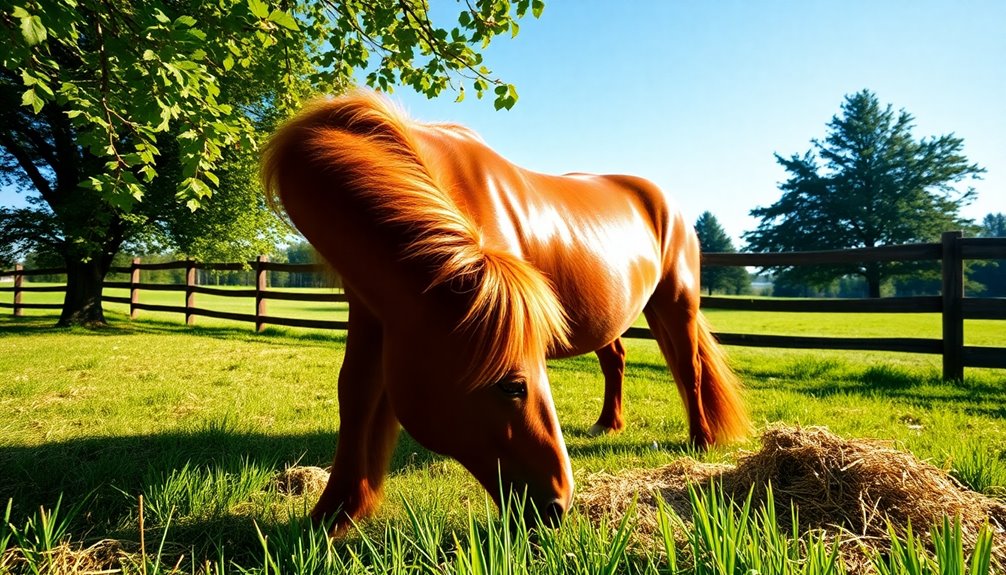
A healthy horse needs to eat 1.5-2% of its body weight in forage daily. For instance, if your horse weighs 1,000 lbs, that's about 15-20 lbs of forage. An 1,100 lb horse should consume around 16.5-27.5 lbs. It's essential to provide high-quality forage, as this supports digestion and overall health. Insufficient forage can lead to weight loss or even colic. Regularly checking your horse's body condition score can help you adjust this intake as needed. There's plenty more to explore about forage quality and feeding strategies that can benefit your horse's nutrition.
Key Takeaways
- Healthy mature horses require 1.5-2% of their body weight in forage daily for optimal health.
- A 1,000 lb horse needs approximately 15-20 lbs of forage each day.
- High-quality forage should be bright, clean, fresh, and free from contaminants.
- Regularly monitor and adjust forage intake based on the horse's body condition score (BCS).
- Horses typically consume 1-2 lbs of pasture dry matter per hour, grazing for about 16 hours.
Forage Consumption Guidelines
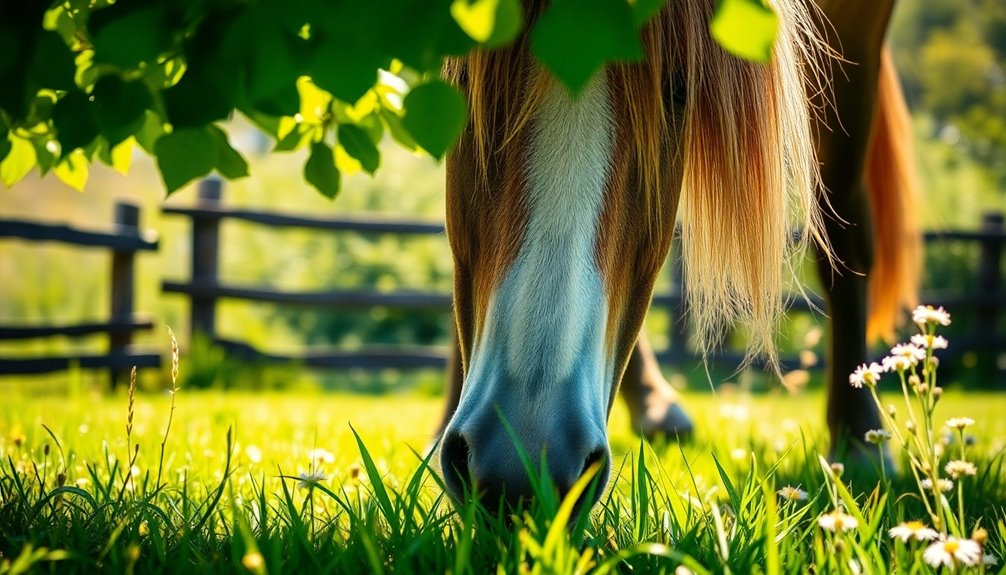
When it comes to your horse's health, understanding forage consumption guidelines is fundamental. Healthy mature horses need about 1.5-2% of their body weight in forage each day. For example, if your horse weighs 1,000 lbs, that's roughly 15-20 lbs of forage. For an 1,100 lb horse, daily intake can range between 16.5-27.5 lbs, depending on their specific needs and body condition.
It's important to recognize that horses typically consume 1-2 lbs of pasture dry matter per hour. This highlights the significance of providing consistent access to quality forage.
If pasture conditions are poor due to overgrazing or drought, you'll need to supplement their diet with hay as if there's no pasture available.
As a horse owner, monitoring your horse's grazing behavior and adjusting their feeding management is essential to guarantee they meet their daily forage requirements. By keeping a close eye on their intake, you can promote better overall health and well-being.
Understanding Equine Digestion
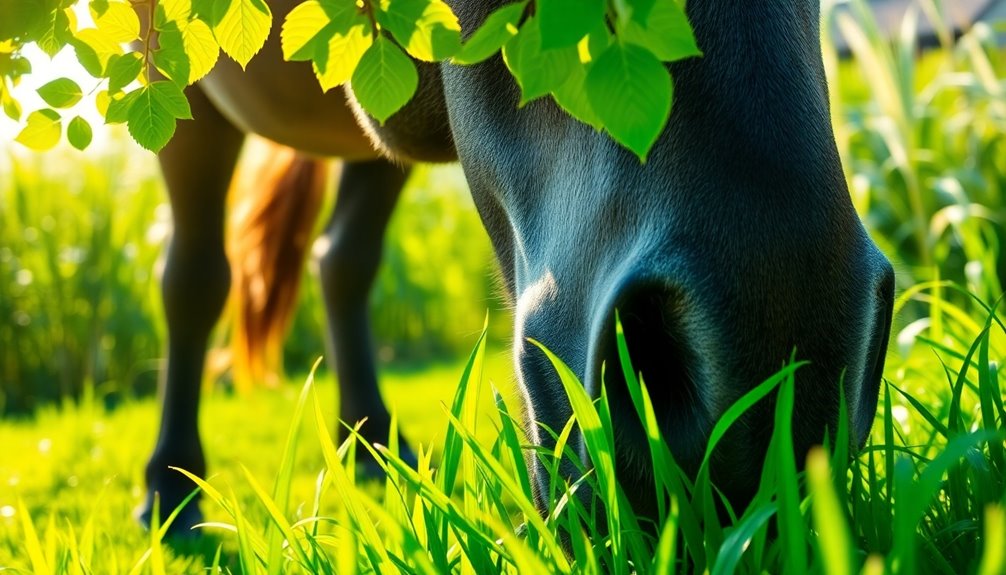
Understanding how your horse digests forage is essential for maintaining its health.
Unlike ruminants, your horse's digestive process focuses heavily on the hindgut, where fiber is broken down into energy.
Forage Digestion Process
As you observe a horse munching on hay, it's fascinating to know that the forage digestion process kicks off the moment they start chewing. This process is important for their overall nutrition and energy levels.
Once the hay is consumed, it travels through the esophagus into the stomach and small intestine, eventually reaching the cecum. Here, specialized microbes—bacteria, fungi, and protozoa—play a significant role in breaking down the fiber.
Key aspects of the forage digestion process include:
- Cecal Fermentation: This is where the magic happens, converting fiber into volatile fatty acids, which are essential for energy.
- Single-Stomach Structure: Unlike ruminants, horses depend heavily on their hindgut for efficient fermentation and nutrient absorption.
- Feeding Order: It's recommended to provide hay first, followed by grain, to minimize digestive upset and optimize forage digestion.
Importance of Fiber
Fiber plays a central role in equine digestion, greatly influencing a horse's overall health and well-being. A diet rich in forage supports proper digestion and gut health by promoting fermentation in the hindgut. For healthy horses, you should aim for 1.5-2% of their body weight in forage daily.
Here's a quick reference table on forage requirements based on body weight:
| Horse Weight (lbs) | Forage Minimum (lbs) | Forage Maximum (lbs) |
|---|---|---|
| 800 | 12 | 16 |
| 1,000 | 15 | 20 |
| 1,200 | 18 | 24 |
| 1,400 | 21 | 28 |
Insufficient fiber can cause serious digestive issues like colic and disrupt gut microbiota balance. Additionally, forage stimulates chewing, producing saliva that buffers stomach acid and helps prevent gastric ulcers. The cecum, where fiber fermentation occurs, is home to microorganisms that convert fiber into volatile fatty acids, providing a primary energy source for horses. Prioritizing fiber in your horse's diet is essential for their health and performance.
Digestive Tract Overview
A horse's digestive system is uniquely adapted to process forage, primarily in its hindgut, which sets it apart from ruminants like cattle. When you feed your horse hay, it travels down the esophagus and into the stomach. Digestion starts here, but most fiber breakdown occurs in the cecum, where a rich community of microorganisms thrives.
These microorganisms play a crucial role in converting fiber into volatile fatty acids, providing essential energy for your horse. However, if toxins are present in the hay, they can lead to digestive issues, as these toxins may pass through the small intestine without being neutralized.
To guarantee your horse maintains a healthy digestive system, consider these tips:
- Always prioritize hay in their diet before introducing horse feed or grains.
- Monitor the quality of forage to prevent potential toxins that could disrupt digestion.
- Maintain a consistent feeding schedule to promote stable gut health.
Understanding your horse's digestive tract is crucial for effective Equine Nutrition. By focusing on high-quality forage, you'll support their overall well-being and prevent digestive upsets.
Nutritional Needs of Horses
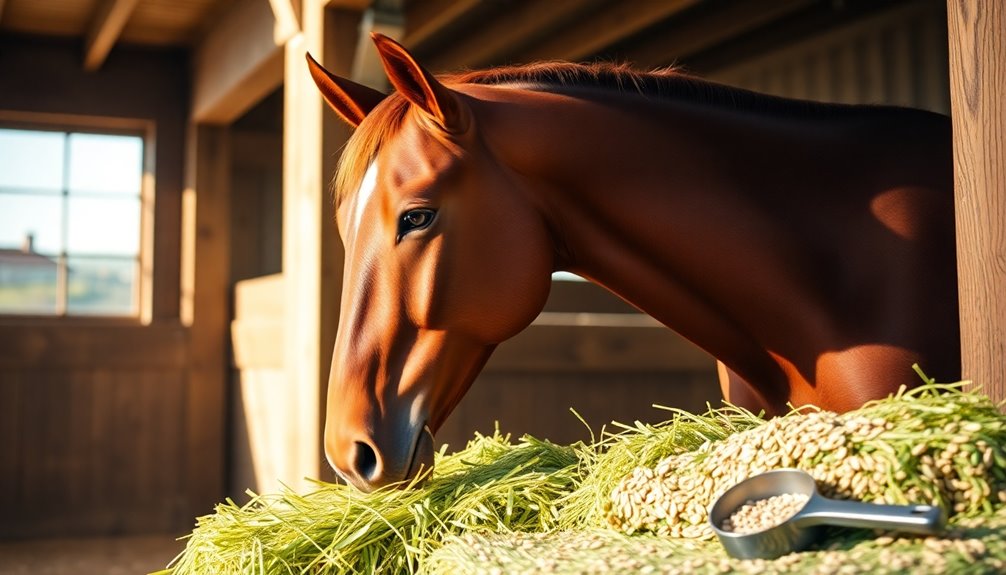
When it comes to your horse's nutritional needs, daily forage intake is essential.
A healthy mature horse typically requires 1.5-2% of its body weight in forage, so knowing the right amount can keep your horse healthy and happy.
Plus, the quality of the forage you choose plays a significant role in supporting your horse's overall well-being and performance.
Daily Forage Requirements
To keep your horse healthy, it's essential to provide enough daily forage, which should be about 1.5-2% of their body weight. For a 1,000 lb horse, that means approximately 15-20 lbs of forage each day. Meeting these nutrient requirements is important, as insufficient intake can lead to weight loss, colic, and behavioral issues due to stress and boredom.
Here are some key points to take into account regarding daily forage intake:
- Horses on pasture typically graze for about 16 hours, consuming 1-2 lbs of pasture dry matter per hour.
- If pastures are overgrazed or lack quality, supplementing with hay is necessary to meet daily forage needs.
- Always introduce new hay gradually over 7-10 days to avoid digestive disturbances.
Maintaining proper forage intake is critical for your horse's overall well-being. Regularly assess their body weight and adjust the amount of hay or pasture accordingly.
Forage Quality Considerations
Ensuring your horse receives high-quality forage is just as important as meeting their daily intake requirements. When you're selecting hay for your horse, focus on forage quality. Good quality forage should be bright, clean, fresh, and free from contaminants. Testing hay is a smart move to guarantee safety and nutritional value.
A healthy mature horse typically requires 1.5-2% of their body weight in forage daily, which means you should provide an appropriate amount of hay—around 16-32 pounds for a 1,000-pound horse.
While alfalfa hay is known for higher protein and energy levels, be cautious; it can lead to digestive issues if water access is inadequate.
Pasture Management Strategies
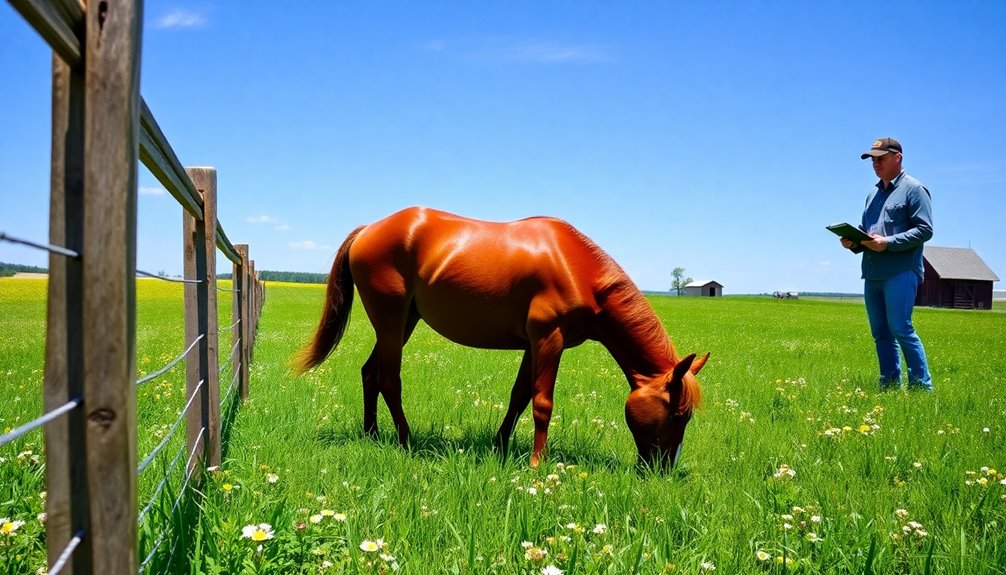
Effective pasture management is vital for maintaining the health and nutritional needs of your horses. By implementing strategic practices, you can guarantee they receive adequate forage while promoting their overall well-being. Here are some key strategies to take into account:
- Rotate grazing areas: This prevents overgrazing, allowing pastures to regrow and maintain quality.
- Monitor grazing behavior: Observing how your horses graze helps assess pasture sufficiency, guaranteeing they meet their dry matter intake requirements.
- Supplement during poor conditions: In winter or drought, provide high-quality hay, haylage, or cubes to meet their caloric needs.
Healthy mature horses typically require 1.5-2% of their body weight in forage daily, which means a 1,000 lb horse needs about 16-32 lbs of forage.
Overgrazed or drought-stricken pastures can limit calorie availability, making it essential to adapt your pasture management approach. By guaranteeing your horses have continuous access to quality pasture, you can satisfy their nutritional needs efficiently.
Monitoring Body Condition
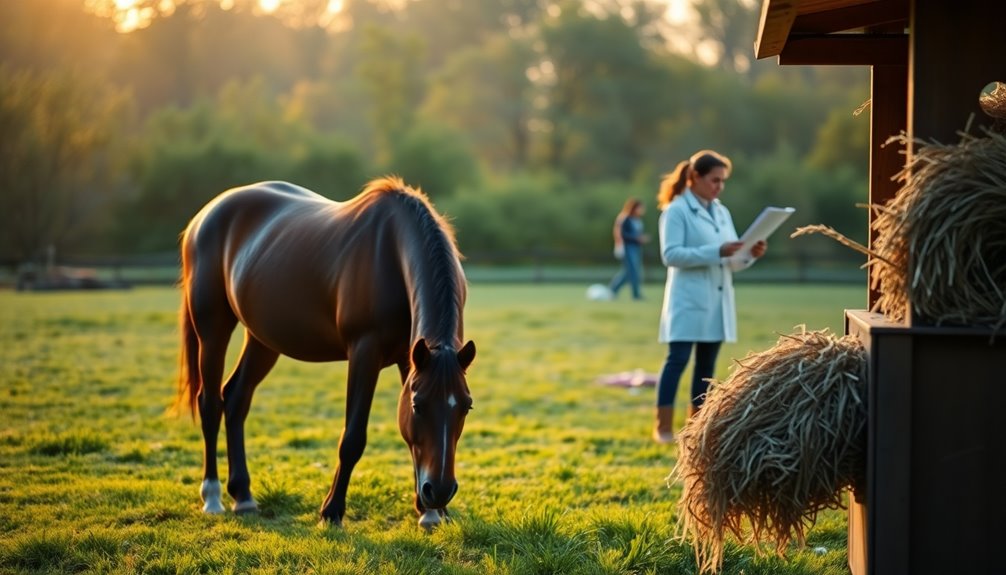
Monitoring body condition is crucial for keeping your horse healthy and meeting its nutritional needs. By using a body condition score (BCS) system, you can evaluate your horse's overall health. This scoring ranges from 1 (emaciated) to 9 (obese). A healthy body condition score typically falls between 4 and 6, indicating your horse has adequate fat cover without being overweight.
Regular weight assessments are essential for tracking changes in body condition. You can use tools like weight tapes or scales to inform dietary adjustments, particularly regarding forage intake. For example, if your horse is overweight, you might need to reduce its forage intake or switch to lower-quality forage.
To effectively monitor body condition, consider the following:
| Body Condition Score | Dietary Recommendations |
|---|---|
| 1-3 | Increase forage intake |
| 4-6 | Maintain current diet |
| 7-9 | Decrease forage intake |
Consistently scoring your horse every 4-6 weeks allows you to monitor progress and make timely adjustments to feeding plans, ensuring your horse maintains a healthy body condition.
Resources for Horse Owners
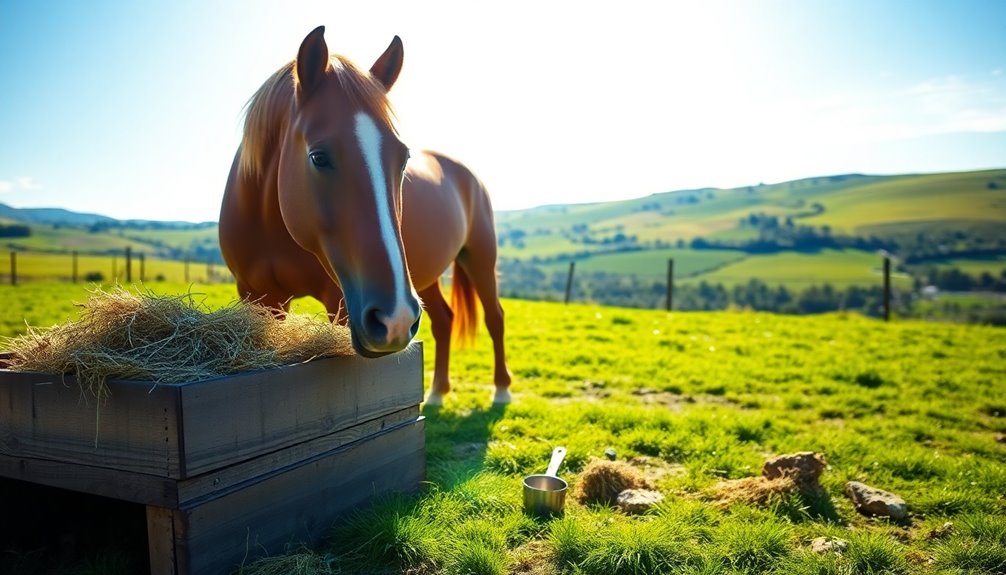
As you focus on maintaining your horse's body condition, it's important to have access to reliable resources that support your efforts in equine nutrition.
Understanding how to assess your horse's forage intake and guarantee they're consuming the right amount of quality hay is vital for their overall health.
Here are some resources that can help:
- National Research Council (NRC): This organization provides extensive guidelines on nutrient requirements, helping you determine the ideal body weight and forage needs for your horse.
- FeedXL Horse Nutrition Facebook Group: Connect with equine nutritionists and fellow horse owners to share best practices and strategies for optimizing horse nutrition.
- Regular veterinary check-ups: Schedule assessments for body condition scoring, which can guide you in adjusting your horse's forage intake as needed.
Frequently Asked Questions
How Much Forage Should a Horse Have per Day?
When it comes to how much forage your horse should have daily, aim for 1.5-2% of their body weight.
For a 1,000 lb horse, that's about 15-20 lbs of forage.
If your horse grazes on quality pasture, they could consume around 1-2 lbs of dry matter each hour.
Always monitor their grazing habits and adjust their forage based on individual needs and pasture conditions to guarantee ideal health and performance.
What Is the Minimum Amount of Forage Recommended for Adult Horses at Maintenance?
You know that feeling when you see your horse happily munching away? It's essential for their health!
For adult horses at maintenance, you should aim for at least 1% of their body weight in forage daily. However, recent guidelines suggest increasing this to 1.5% for better well-being.
What Is the Minimum Forage Intake Recommendation for Most Mature Horses?
The minimum forage intake recommendation for most mature horses is about 1.5% of their body weight daily.
For a typical 1,000-pound horse, that means they should get around 15-20 pounds of forage each day. This amount helps maintain their health and prevents issues like weight loss or colic.
It's essential to guarantee your horse has continuous access to quality forage to support their gut health and overall well-being.
How Much Should I Feed My Horse per Day?
When deciding how much to feed your horse daily, aim for about 1.5-2% of their body weight in forage.
For a 1,000-pound horse, that's roughly 15-20 lbs. If your horse's in light work, lean toward the higher end to keep them healthy and performing well.
Always guarantee they've access to quality forage, as insufficient intake can lead to weight loss and potential digestive issues like colic.
Conclusion
In the world of equine nutrition, finding the right balance is key. While a horse thrives on ample forage, too little can lead to health issues, just as too much can result in obesity. You need to monitor your horse's body condition closely, ensuring they get the nutrients they require without overindulging. By managing pastures wisely and staying informed, you can provide the best care for your equine companion, keeping them healthy and happy in every season.
-

 Foraging Basics1 month ago
Foraging Basics1 month agoAdd a Forage Certificate to Your LinkedIn Profile and Level Up Your Career
-

 Edible Wild Plants1 month ago
Edible Wild Plants1 month agoUnbelievable Power: The World's Most Formidable Forage Harvester
-

 Foraging Basics1 month ago
Foraging Basics1 month agoForage the City: Your Guide to Successful Urban Foraging
-

 Foraging Basics1 month ago
Foraging Basics1 month agoThe Shocking Truth About Foraging (That Experts Don’t Want You to Find Out)
-

 Foraging Basics1 month ago
Foraging Basics1 month agoThe Resume Hack That Will Make Your Foraging Experience Stand Out
-

 Recipes and Preparation1 month ago
Recipes and Preparation1 month agoThe #1 Sought-After Forage That's Transforming Livestock Nutrition
-

 Recipes and Preparation1 month ago
Recipes and Preparation1 month agoThe One Wild Edible That Will Transform Your Cooking (And It’s Free!)
-

 Foraging Basics1 month ago
Foraging Basics1 month agoDiscover the Largest Forage Wagon in the World!




